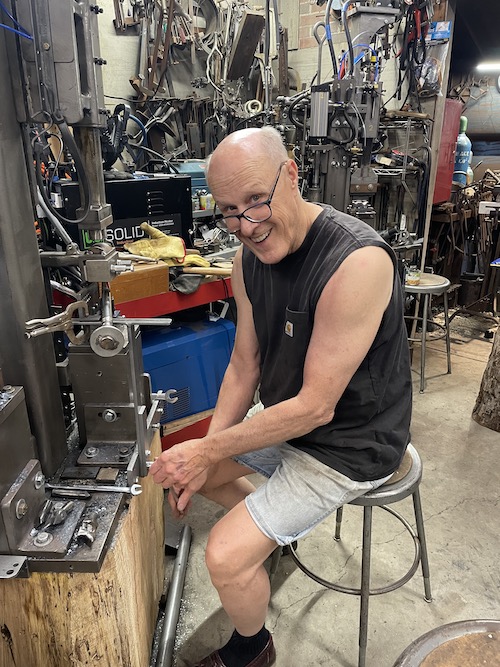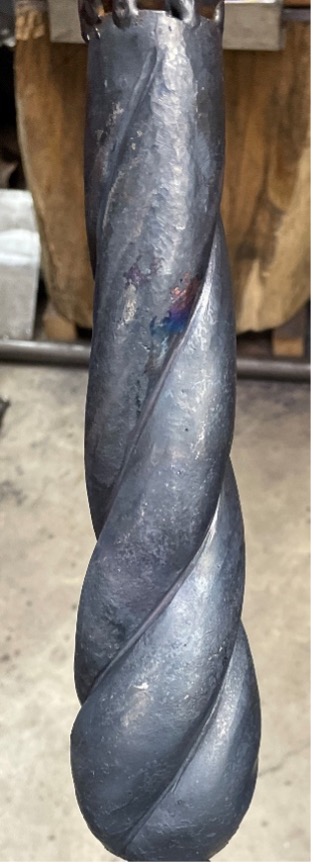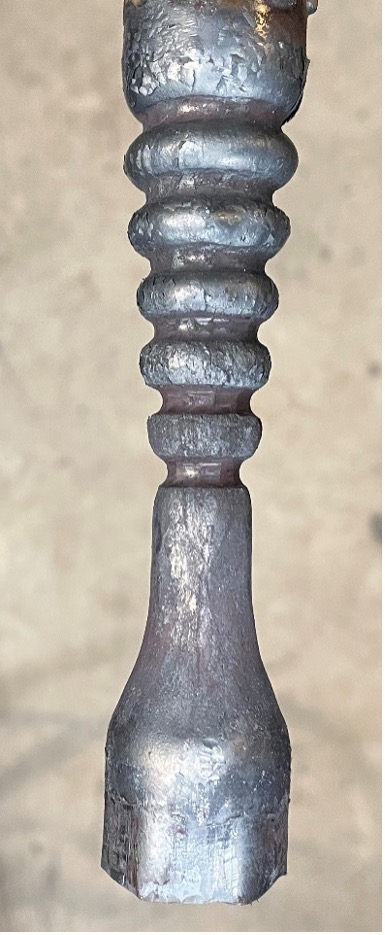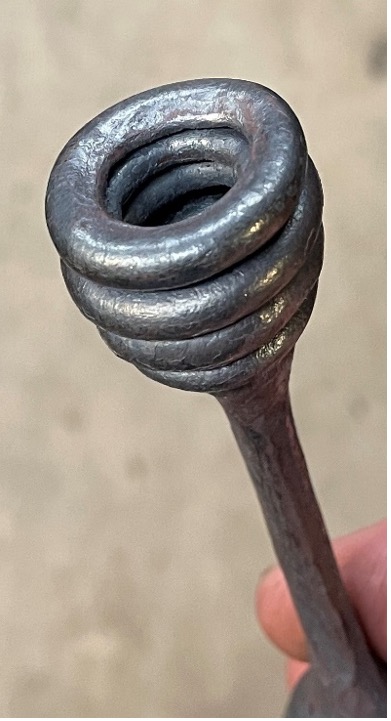The Art of Tube Forging Click here to return to the Tube Forging page

I call myself an artistic blacksmith. Iron is a wonderful material to express art, but it traditionally has not been used for delicate forgings, like flowers that look like natural flowers. You know—light, airy, thin and delicate. And yet, silver and goldsmiths fabricate hollow forms that are very delicate, just like real flowers, all of the time. Could I, as a blacksmith, ever approach that same fine detail in iron by forging hollow tube?
It has taken a decade for me to develop new forging techniques, but these techniques now allow me to make those delicate flowers. I can hot forge thin-walled tube into delicate, complex hollow forms, using a free-form method that allows many varied shapes to be forged using dies having a general design. Little did I envision that flowers would just be the beginning. Nature is loaded with hollow forms like seed pods, fruits and vegetables of seemingly limitless variety. It is inspiring. Equally inspiring is human world of arts and crafts. It is full of creative forms as seen in paintings, stonework, ironwork from the masters, jewelry, movies like “Alice in Wonderland” or “Avatar”— and as I discovered—textiles, especially embroidery. The creativity and imagination in embroidery is exceptional. But not until recently would I ever have thought of blacksmithing and embroidery in the same thought. I do now, and it has led me to develop new technical methods that lead to unique forms. As one example, two strings of disks are shown in figure 2. What an unusual form, one that I do not ever recall having seen, even in Nature. But the string of disks did not suddenly pop into my head. I was shown it by Ms Canby Robertson, a master embroiderer, in a picture of 1600’s English embroidery, in two dimensions of course. I was immediately engaged in making my interpretation of it. She and her craft have been an inspiration to me for creative ideas in steel that are derived from embroidery.
Earlier I referred to technical advances that I developed. There were two technical achievements that allowed me to forge the sculptures that follow. One advance was for me to think differently. I call it “thinking in tube.” The other advance was developing the hammers and tooling in collaboration with Mr Dave Hammer to forge tube.
Thinking in tube was the first advance. Hollow round tube forging is very different from forging solid bars, the usual material used in traditional blacksmithing. For forging tube, traditional blacksmithing methods often do not work. Tube moves differently under the hammer and anvil. Understanding that difference and learning how to master it requires a different way of thinking and has led to creativity and excitement. And on top of it all, it has been a delight to make these forms.
Hammers and tooling was the second advance. Precise air hammer control and special dies are necessary for tube forging. I use three custom air hammers built by Mr. Dave Hammer and hand-make all dies. These combine to make thin-walled tube forging easy to accomplish.
One might ask why take on this challenge, since most of us have thought that round, thin-walled hollow tubes are nearly impossible to forge in a typical blacksmith shop. One answer is simply that it was there for the challenge. Perhaps a more convincing answer is to show some examples. Each example that follows is composed of different flowers, bulbs, seed pods and some unusual forgings like the string of disks. Each tubular-shaped form is forged as a hollow forging. Flat elements are formed from sheet steel, bronze, copper-nickel and copper. Colors are applied mainly using children’s crayons and wax finishes.

Figure 1 Hooked rug-based sculpture, mounted in found frame, 18X24 inches. Hollow elements were forged from 7/8 and 5/8 inch tube having 18-gauge wall thickness using free form Vee dies.
This iron sculpture was based upon a hooked rug shown in the next image. The rug was bought at an auction by Ms. Lynn Jarrell. It contains many whimsical elements and shows the challenge of interpreting a two-dimension object into a three-dimensional sculpture.


Figure 2 Embroidery (by Canby Robertson) based sculpture mounted on slate, 16X21 inches. Hollow elements were forged from 1, 7/8 and 5/8 inch tube having 18-gauge wall thickness using free form dies.

Figure 3 Embroidery based sculpture, mounted on slate. 16x21 inches. Hollow elements were forged from 1 inch tube having 14-gauge wall thickness using fixed form dies.
This iron sculpture was based on an embroidery pattern designed by Ms Canby Robertson and embroidered by Ms Mary Jarrell.


Figure 4 Hooked rug-based sculpture, 18X24 inches. Hollow elements were forged from 1 inch tube having 14-gauge wall thickness using fixed form dies.

Figure 5 Tiffany style vase inspired sculpture, mounted on slate, 16X8 inches. Hollow elements were forged from 1? inch tube having 14-gauge wall thickness using fixed form dies.

Figure 6 Nature inspired trumpet flower of five sides and two triangular shoots, 9X16 inches. Hollow elements were forged from 1? inch tube having 14-gauge wall thickness using free form Vee dies with 108-degree and 120-degree angles.

Figure 7 Nature inspired flower buds with five sides each. Hollow elements were forged from 5/8 inch tube having 18-gauge wall thickness using free form dies with 108 degree Vee angle.

Figure 8 Nature inspired Blue Bells with climbing vine, 8X16 inches. Hollow elements were forged from 1 inch tube having 14-gauge wall thickness using fixed form dies.

Figure 9 Nature inspired trumpet flowers, Ivy leaves and climbing vine, 8X16 inches. Hollow elements were forged from 1inch tube having 14-gauge wall thickness using fixed form dies.

Figure 10 Nature inspired hexagonal hollow vessel flower, 6X10 inches. Hollow elements were forged from 1? inch tube having 14-gauge wall thickness using free form dies having 120 degree Vee dies.

Figure 11 Tiffany inspired hollow vase, 3X10 inches. Vase is forged from 2 inch tube having 14-gauge wall thickness using free form dies and swinging arm method for axial grooves.

Figure 12 Nature inspired Magnolia branch with found Alabaster flower, 8X16 inches. This is an early version of the hollow forging technique. It was forged from ? inch solid rod with one end drilled out and forged with fixed form dies to form a flare to hold the flower.

Figure 13 Hollow, one-piece mushroom, 1? X 2? inches. Mushroom is forged from 1 inch tube having 18-gauge wall thickness using free form dies and pushing the lower stem section into the upper cap section.
Being able to forge thin-walled tube has also allowed other special effects to be made. In the next two figures, the basic shape of the tube has been forged and has been followed by grooving methods to create a spiral or corrugated beehive effect.
 .
.  .
. 
Figure 14 In this sequence, the 2 1/2 inch diameter forged tube on the left was marked with ink to lay out the spiral, by eye. The three-start spiral was made in segments to keep a constant distance between grooves. The initial groove was forged cold to get a well-established groove and then deepened hot.
 .
.  .
.  .
. 
Figure 15 A cocoon form. The stem allows them to be hung on a branch so that the butterfly inside can emerge. The three right pictures show a similar forging that has been collapsed into a beehive-like form.
What follows are three pedestal tables where the central pedestal is a hollow forging.

Figure 16 Queen Anne style tripod tea table, 10X16 inches. Hollow elements were forged from 1? inch tube having 14-gauge wall thickness using free form dies and swinging arm method for spiral grooves and finishing dies for the ball.

Figure 17 This shows a Queen Anne style tea table with a three groove spiral. The height is 26 inches. The top is Mahogany wood and 18 inches in diameter.

Figure 18 This shows a Queen Anne style tea table with a four groove spiral. The height is 25 inches. The top is Walnut wood and 18 inches in diameter.
Click here to Return to Tube Forging Page